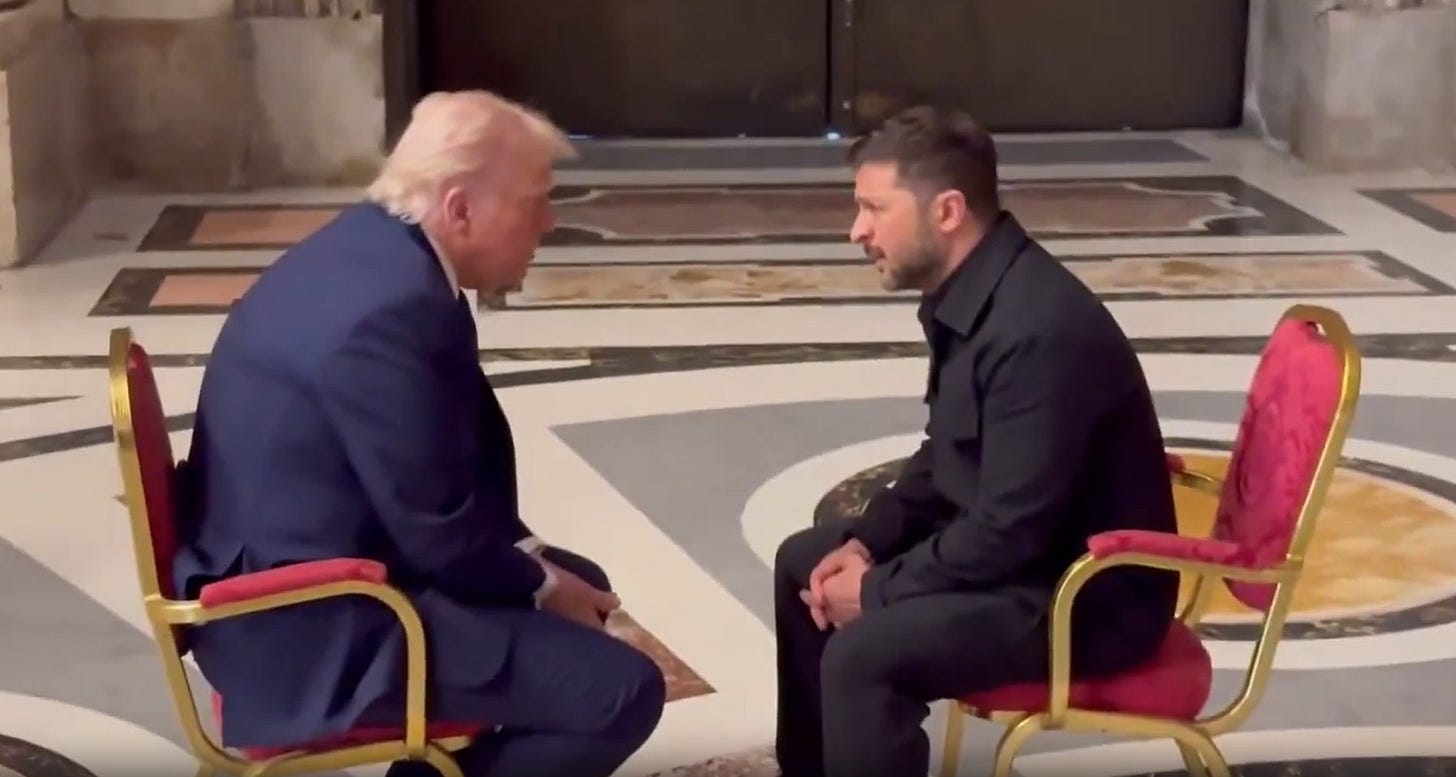Zelensky Rejects Putin's Trick-Fire
Putin asked for silence. Zelensky offered him exposure.
I’ve always worried about President Zelensky’s political nous — that ugly little ability to play the game. The man is stubborn to a fault. That look on his face this week, when he was sitting across from Donald Trump at the Vatican, was a story in itself. Or we could rewind to the Oval Office — that brutal moment when Trump and J.D. Vance piled onto him in front of the cameras, turning him into a gut-wrenching spectacle for the world.
Was that necessary? Did he need to endure all that? Why not just sign over Ukraine and get some rest? All that pressure, all that pain — why not just give in?
He won’t. He’s more likely to dig in than give in.
That inability to play the manipulators’ game, while sitting squarely in the middle of global power politics, is exactly why so many of us feel tethered to his vision of the future.
It’s also his blind spot. He’s surrounded — not by soldiers, but by strategists who’ve played this game for decades. He doesn’t need to become one of them. I don’t want that. I just want him to find advisors who can play it on his behalf. People who can feed him ideas that push the battlefield — political, economic, moral — back in Ukraine’s favor.
And the truth is: he’s getting better. His responses to Putin’s tricks are less reactive now. Sharper. More composed. The ground is still brutal, but he’s learning how to stand on it without losing himself.
Putin’s latest maneuver is as transparent as it is cynical.
First, he asked for a two-day ceasefire around Easter. Now he’s asking for silence on March 7th and 8th — conveniently timed to coincide with Victory Day parades in Russia. It’s not a peace offer. It’s a public relations stunt. A distraction designed to shift the conversation away from Donald Trump’s proposed 30-day ceasefire plan — a plan that, for all its flaws, at least carried weight in Washington.
Zelensky saw through it immediately. And he said so:
We in Ukraine never wanted a single second of this war. Back on March 11, we responded positively to the American proposal for a full ceasefire. We made our own proposal to Russia – bilaterally – to halt strikes at least on civilian targets. We also proposed making the Easter ceasefire full and extending it for thirty days.
Russia has consistently rejected everything and continues to manipulate the world, trying to deceive the United States. Now, yet again, another attempt at manipulation: for some reason everyone is supposed to wait until May 8 before ceasing fire — just to provide Putin with silence for his parade.
We value human lives, not parades. That’s why we believe — and the world believes — that there is no reason to wait until May 8. The ceasefire should not be just for a few days, only to return to killing afterward. It must be immediate, full, and unconditional — for at least 30 days to ensure it is secure and guaranteed. This is the foundation that could lead to real diplomacy.
We reaffirm this proposal. The American proposal also remains on the table. Russia knows exactly what it needs to do and how to respond: to genuinely cease fire.
The old Zelensky would have rejected Putin’s proposal outright. The new Zelensky is doing something smarter — he’s countering it with a better one. And not his own, but the one placed on the table by the Trump administration.
That shift reframes the debate entirely.
It’s no longer: “Why won’t Ukraine accept a few quiet days?”
Now it’s: “Why won’t Putin accept a full 30-day ceasefire?”
There’s a reason for that. Putin’s entire war posture depends on ambiguity. His economy is bleeding, and he needs to keep the option to end the war close — but also keep fighting just long enough to delay collapse. These one- or two-day ceasefires are not peace offers. They’re optical escape hatches. They let him posture as reasonable, while keeping the war on a rolling loop — one more week, one more parade, one more PR stunt.
But a 30-day ceasefire breaks that pattern.
Why? Because thirty days means monitoring. It gives international observers time to deploy. And once monitors are in place, any breach is documented — not just whispered about. If Putin violates the ceasefire then, it won’t be Kyiv’s word against Moscow’s. It’ll be the monitors’ word against the Kremlin.
And that’s when things get dangerous — not militarily, but politically.
Because if Putin’s violation is publicly confirmed, Trump won’t have room to spin it. He’ll be cornered. Either he backs Ukraine, or he exposes himself.
That’s the trap.
Zelensky isn’t just rejecting Putin’s game anymore. He’s rewriting the rules.
And now Putin has two choices:
Accept the 30-day ceasefire — or explain to Trump why he won’t.





australia wanted to snd their old armb tanks to ukraine, america refused to sanction the deal, at least the world knows where trump stands
" We need ammunition not a ride" a statement worthy of Winston Churchill. Yes, he has grown in stature and command; there is only one.